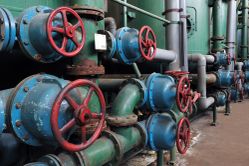A Guide to Understanding Your Industrial Water Analysis Report

Both the Earth and the human body are a majority water. More surprising to some is how much water is used in the production of goods—from cars to electronics. However, if you are a manufacturer, you understand just how critical of an ingredient water can be—for cooling, purifying, transporting, or powering parts of your operation. Any contaminants in it could harm the goods you are trying to produce. Take the iPhone®, for example, whose tiny microchips must be washed in between steps with water so clean, it is actually dangerous for human consumption. Therefore, after determining what source to use, testing must be performed so you know what water treatment is necessary. The guide below offers advice for processing the information on this report.
3 Tips for Interpreting Water Composition
1. Know Your Industry Standards
From fertilizer runoff to prescription medications that are flushed down the toilet, water supplies get contaminated with many hazardous substances, making water treatment necessary if any of these are found in units over the legal limit. For mercury, for example, that concentration is 0.144 mg m-3 if you are making products to be consumed. However, other goods may have different guidelines, which you should then compare to the findings on the report.
2. Understand Its Effect on Your Equipment
 Even if the contaminants in your water comply with regulations, you might consider additional water treatment anyway—since any amount of calcium, magnesium, or iron in the water has the potential to cause lime build-up in the pipes, which can make the whole system run less efficiently. Alternatively, it could cause your plumbing or the metal in your product to corrode. On the report, values should be given for both the hardness and the pH of your water. In the first case, you want results as close to 0 mg/L. The ideal pH value is 7, meaning the water is neither too acidic nor too basic.
Even if the contaminants in your water comply with regulations, you might consider additional water treatment anyway—since any amount of calcium, magnesium, or iron in the water has the potential to cause lime build-up in the pipes, which can make the whole system run less efficiently. Alternatively, it could cause your plumbing or the metal in your product to corrode. On the report, values should be given for both the hardness and the pH of your water. In the first case, you want results as close to 0 mg/L. The ideal pH value is 7, meaning the water is neither too acidic nor too basic.
3. Consider the Options
There are many ways to conduct water treatment—from water softeners, which add substances to the water to cancel out the effects of other contaminants, to reverse osmosis systems, which remove the offending particles altogether. The right choice will depend on your industry—or in some cases, you might utilize both, softening the water used to power equipment, so it doesn’t corrode pipes, while purifying the water that directly interacts with the product. Consult the professionals who conducted the analysis to better understand these methods, as well as your results.
Interested in water testing? Turn to the experts at Western Environmental Management in Carlsbad, NM. With over 30 years of industry experience, they can both help you break down your analysis report as well as provide top-of-the-line water treatment, in the form of demineralizers, water softeners, or reverse osmosis systems. Visit them online to learn more about these and other services. Or call (575) 885-5709 to schedule a meeting.
About the Business
Have a question? Ask the experts!
Send your question

